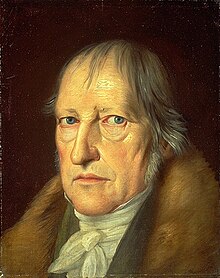The question of time's reality
On What Is: "but not ever was it, nor yet will it be, since it is now together entire, single, continuous; for what birth will you seek of it? How, whence increased?" — Parmenides of Elea (5th century B.C.)
Reality appears to take place not just in space, but in time. In science after Newton, it is common to treat space and time as a great canvas where events can take place: a supernova explosion; a moon landing; your first kiss.
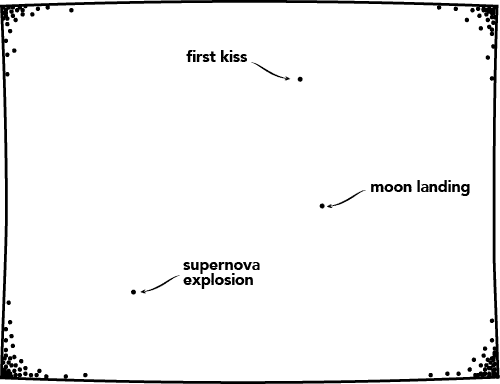
Space (left-right) and time (up-down) as a great canvas
It is possible possible to deny that time, as well as space, have any sort of independent reality. A version of this denial was formulated by Parmenides of Elea in 5th century Greece, and played an essential role in Leibniz's relational view of space and time:
"I hold space to be purely relative.... I hold it to be an order of coexistences, as time is an order of successions" (Leibniz, from the Leibniz-Clarke Correspondence, pg.14).
Many find it hard to say that time is a mere "order of successions" as Leibniz would have it. Time seems to flow inevitably forward like a river, sometimes fast and sometimes slow, carrying us from past to future whether we like it or not. The flow of time is an aspect of our experience that we are rarely confused about.
However, there are illusions that appear to be temporal in nature. To begin, notice that if an object is rotating in one direction, then reversing the time order is equivalent to reversing the rotation.
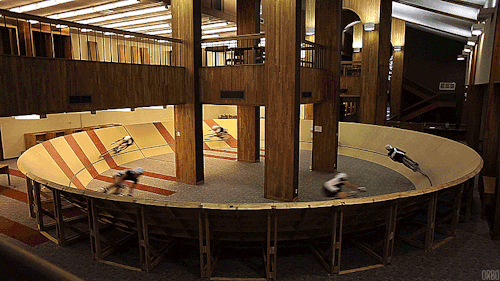
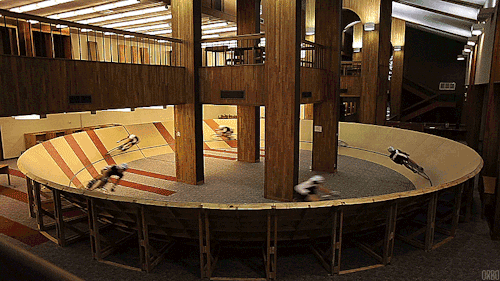
Cyclists rotating in the opposite direction have their time-order reversed.
This makes it possible to view certain kinds of illusions, such as the Spinning Dancer illusion, as temporal in nature. The dancer appears to some as rotating clockwise from above, and to others as rotating anticlockwise. Some even report noticing the orientation seem to spontaneously switch. This illusion can be interpreted as disagreement about the time-order of events describing a rotating dancer.
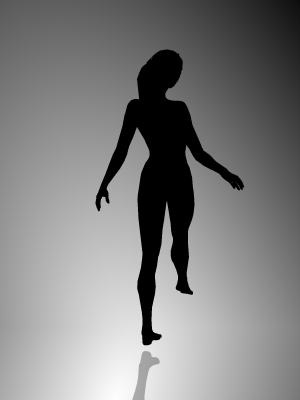
The Spinning Dancer illusion
But can one give any principled reason to believe that time does or does not exist? As philosophers, we will attack this question by first trying to clarify what we mean by time. Our discussion will follow an enormously influential article arguing for the unreality of time, authored in 1908 by John McTaggart, a philosopher at Trinity College, Cambridge.
Characterising the Facts About Time
The A Series, B Series, and C Series
As a philosopher should, McTaggart begins by clarifying his central terms, by distinguishing two sorts of facts about time. His proposal here has become one of the most influential ways to think about time in modern philosophy. He expresses the distinction as follows.
"Positions in time, as time appears to us prima facie, are distinguished in two ways. Each position is Earlier than some, and Later than some, of the other positions. And each position is either Past, Present or Future." (McTaggart 1908, pg.458)
McTaggart calls the first kind of fact B Series, describing facts about the directed ordering of events in time. One B Series fact is the statement, "Harold II is coronated and later he is killed.". Another is, "My breakfast today is earlier than my supper today". Such statements describe not just an ordering of facts, but also that there is a preferred 'direction' to them: the 'arrow' of time goes from earlier vents to later events.

B Series Fact places events in an order, and also gives them a direction.
The second kind of fact is called A Series. The A Series facts include, "My reading of this sentence is the present." Or, "Harold II was coronated in past." One of the central features of the A series is that it is constantly changing, as we change the events we take to be past, present and future. For example, The first time you read these lecture notes is an event that will change from being future, to present, to past.
There is a third kind of fact about time that McTaggart discusses. After introducing the A and B Series, he describes what he calls the C Series. The C Series facts are very similar to the B series, but lack a direction. For example, suppose I were to describe an ordering of four players of a game by drawing images of the players in a row, as below. This ordering is not directed, because it doesn't describe who went first. But it can still correctly describe a fact about the 'undirected' order of the players.




Ordering of players in a game, without specifying which is the 'first' player.
We can summarise McTaggart's three kinds of temporal facts in terms of space-time diagrams, with time described by a vertical axis and space by a horizontal axis:
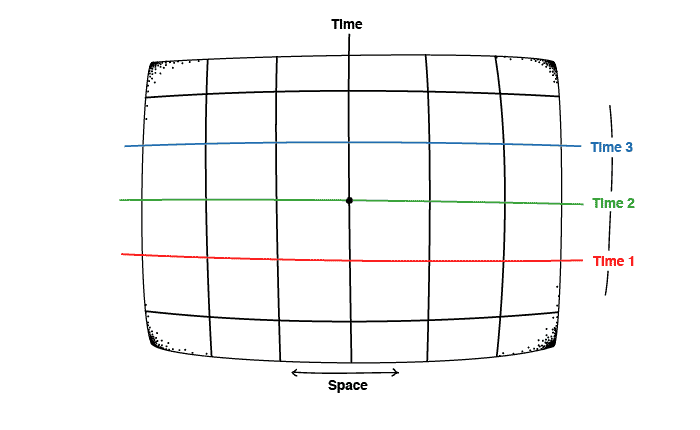
The C Series: An ordering of events, without saying which direction (up or down) is the future.
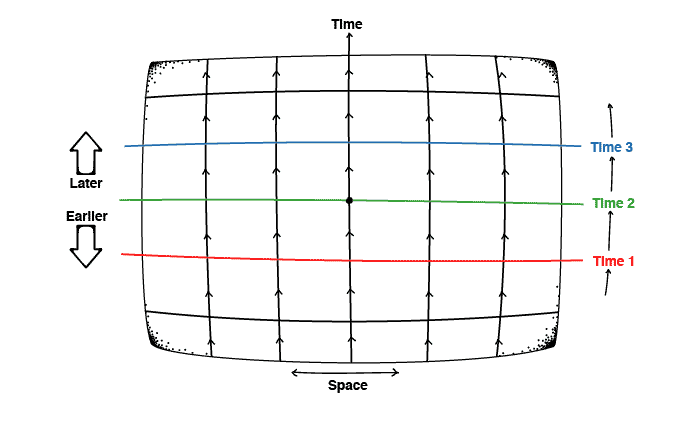
The B Series: An ordering of events with designated (future and past) direction
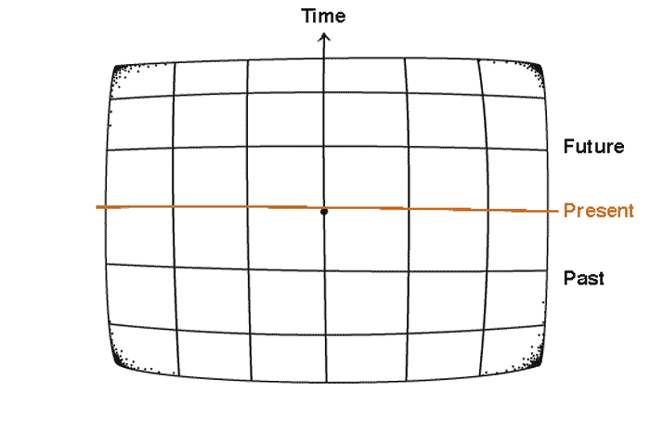
The A Series: A changing description of what events are past, present and future
Properties of the Time Series
The A Series describes a property often referred to as temporal passage: the changing status of events from future to present to past. If an event is present now, then it won't be for long! It will soon recede into the past. Similarly, if an event is in the future, then it will eventually become present, and then it will be past.
In contrast, the B Series and C Series describe permanent properties and relations between events: if one event is earlier than another, then this fact does not change, unlike facts about whether either of the events happen to be 'in the present'.


B Series and C Series facts describe fixed, 'permanent' properties and relations between events.
The relationship between the three time series, according to McTaggart, is that the C Series and the A Series determine the B Series. McTaggart thinks the C Series isn't even really temporal: given a bare ordering of events described by the C Series, with no 'direction' indicating past or future, it is hard to see any sense in which we're talking about time. In other words, an adequate description of time needs a direction. What is the origin of the direction of time? McTaggart says it is our experience of temporal passage from future to present to past. This determines the appropriate 'future and past directions' associated with the B Series. He writes:
It is only when change and time come in that the relations of this C series become relations of earlier and later, and so it becomes a B series.
Why is the A Series the appropriate way to understand where this direction comes in? One reason McTaggart gives is that the A Series appears central to our perception of time:
"We perceive events in time as being present, and those are the only events which we perceive directly" (McTaggart 1908, p.458).
In particular, we anticipate the future and anticipate the past in order to describe orderings in time. But it seems that our only direct observations are A Series claims about time, and in particular they are claims that involve describing the present. In summary, we might write McTaggart's claim as follows.
C+A → B
Note that McTaggart also suggests his claim here is supported by the language of Hegel's Science and Logic. We don't need to go into the details of that language. But for the brave, try the button below.
McTaggart's Hegelian Paragraph
Argument for the Unreality of Time
With this background in place, McTaggart constructs an argument that time is not real. The argument has two parts: first, establish beyond question that the B Series and C Series are not sufficient to describe time. Then, show that the A Series suffers from an intractable incoherence. That is, the argument has the following form:
If time is real (independently of human thinking), then it must be described using the A Series, B Series or C Series. But it cannot be adequately described by these Series; therefore, time is not real.
Inadequacy of a mere B Series or C Series
McTaggart's discussion of how the B Series is determined by the A Series already suggests that time cannot be adequately described without the A Series. However, he then gives a more powerful argument against describing time using the B Series alone.
McTaggart's central concern is that the B and Series are not enough to describe temporal passage. The C Series isn't even associated with a direction, and so could not describe the direction of passage. Both of these descriptions involve 'permanent' relations and properties of events. If one thing is earlier than another in time, then it always is.
Thus, it appears that, although the B Series at least admits a direction for time, the B Series cannot describe change of the kind required to describe temporal passage of an event from future to present to past.

The A Series provides a notion of change or 'temporal passage' of events from future to present to past.
Why is change so important? McTaggart thinks it is central to the nature of time:
"A universe in which nothing whatever changed (including the thoughts of the conscious beings in it) would be a timeless universe." (McTaggart 1908, pg.459)
This idea, that there is no time without change, is an old one that can be found in Aristotle's Physics. It is also a not so obvious that it is true. It seems obvious that describing change requires time, if by 'change' we mean 'change over time'. But, is it also true that we cannot describe time without change? Imagine a frozen universe, in which all motion and change stopped, as in the photograph below. Would this really be a universe in which time never passes?

A photograph is a motionless, changeless description.
If McTaggart is right that time requires temporal passage, then we have the following powerful argument against describing time only in terms of the B-Series.
McTaggart's Rejection of the B-Series (Reconstructed from pg.459)
- (Premise): If only B-Series statements are true, then there is no temporal passage.
- (Premise): If there is no temporal passage, then there is no time.
- (Conclusion): Therefore, if only B-Series statements are true, then there is no time.
This is a valid argument. And, if it is sound, then it provides strong reason to reject a description of time in terms of the B Series alone. Notably, this same argument also applies to the C Series.
McTaggart concludes not only that you can't have the B Series without the A Series, but that you can't describe time without the A Series. Our only hope for a 'real' description of time thus lies in our ability to develop a realistic interpretation of the A Series.
Incoherence of the A Series
What is not a problem
Let's begin with some possible concerns about the A Series, but which McTaggart is not bothered by.
Non-Concern 1. The A Series doesn't adequately describe time in fiction. We can describe time in fictional stories like Don Quixote. And yet, these stories do not necessarily involve any statements of temporal passage from future to present to past. So, perhaps the A Series isn't necessary after all.
McTaggart is not concerned by this objection, arguing that his discussion is about how to describe passage in real time. Since fictional stories are not real, and so his claim that 'time is unreal' already applies trivially to them. The more interesting question is whether time is real for real states of affairs; and, for this question, Don Quixote lies outside the scope of the discussion.

Don Quixote is part of a fictional narrative in time. But McTaggart is only concerned with non-fictional reality.
Non-Concern 2. The A Series might be individual-relative. This is a profoundly interesting point: perhaps there is not one notion of ordering determined by temporal passage, but many! McTaggart entertains this idea following a suggestion of British idealist F.H. Bradley. But, once you learn a little bit about modern spacetime physics, you find that there are various scientific senses in which this is really the case: observers travelling at different speeds have different judgements of which points are simultaneous or 'present'; this is known in the philosophy of physics as the relativity of simultaneity, discovered by Einstein in 1905.
But, McTaggart is not bothered by this concern either. There being multiple different notions of temporal passage is independent of their reality. And, McTaggart's central concern is about their reality: is it possible for any one of them, or all of them, to be real? He writes:
"then no time would be the time — it would only be the time of a certain aspect of the universe. It would, no doubt, be a real time series, but I do not see that the present would be less real than the time" (McTaggart 1908, pg.466)

McTaggart considers the possibility that there might be many independent notions of temporal passage.
What is a problem
What McTaggart does think is a problem is how to make sense of the change described by the A Series. Although this change appears to be central to how humans think of time, it is not so clear how to make conceptual sense of it.
McTaggart's argument can be neatly summarised as follows.
McTaggart's Rejection of the reality of time (reconstructed from pgs.469-470)
- (Premise): If time is real, then there is real change (temporal passage).
- (Premise): If there is real change (temporal passage), then it must be A Series change.
- (Premise): A Series change is incoherent, leading either to circularity or to an infinite regress.
- (Conclusion): Therefore, time is not real.
The first two premises summarise the conclusion of McTaggart's previous argument against the B and C Series. So, let us proceed straight to the third.
What is the problem with temporal passage? Recall that temporal passage describes how events change from being future to present to past. One simple way to put the problem is to ask, when we say events change, what are they changing with respect to?. There does not seem to be an easy answer.
In the first place, McTaggart reminds the reader that "[p]ast, present and future are incompatible determinations" (McTaggart 1908, pg.468). That is, an event cannot be all three at once: it must change whether it is past, present or future, not only because this is how the A Series determines a direction of time, but on pain of contradiction.
But what is that change? One might wish to say that temporal passage is change with respect to time: an event was future, then later in time it is present, and then later in time it is past. Unfortunately, McTaggart points out, there is a problem with this:
"this explanation involves a vicious circle. For it assume the existence of time in order to account for the way in which moments are past, present and future. Time must then be pre-supposed to account for the A series. But we have already seen that the A Series has to be assumed in order to account for time." (McTaggart 1908, pg.468)
A circular definition is one that makes use of the very thing that it aims to define. In this case, McTaggart already takes time to be defined by A-Series temporal passage. So, he cannot also define temporal passage as a change in time — this makes the definition trivial and uninteresting! (You may recognise this objection as similar to the circularity objection in Moore's Proof of the External World.)
So, if the change from future to present to past is not a change in time, then what sort of change is it? We might call it change with respect to 'time2', a second notion of time. This would allow us to say that temporal passage is change with respect to time2.
This is in effect what we do when we produce an animation of temporal passage, as below. One notion of time is as a coordinate on the black and white space in the background. Another notion of time is the distance from the orange 'present' line, which we call 'time2'. They are different notions of time, and so there is no circularity in defining one in terms of the other.

An animation of temporal passage is change with respect to a new time parameter.
But now we can ask the same question about time2. McTaggart suggests that it too should be described in terms of an A Series, and so to avoid circularity, it too should be described as change in terms of a new notion of time, which we might all time3. But now we are in danger of an infinite regress:
"It may be doubted whether any intelligible meaning can be given to the assertion that time is in time. But, in any case, the second A series will suffer from the same difficulty as the first, which can only be removed by placing it inside a third A series. The same principle will place the third inside a fourth, and so on without end. You can never get rid of the contradiction, for, by the act of removing it from what is to be explained, you produce it over again 'in the explanation." (McTaggart 1908, pg.469)
He thus concludes:
"We have come to the conclusion that the application of the A series to reality involves a contradiction, and that consequently the A series cannot be true of reality."
McTaggart finds this perspective natural given the nature of human psychology: the notion of 'present' is hard to define, since there is in general some time lapse between the occurrence of the event and our brain's processing of it; William James referred to this as the 'specious present'. Since our experience of the present is associated with a number of highly subjective contingencies to do with the workings of our individual minds, it is in a sense much more natural to identify the 'present' as subjective, rather than an objective feature of reality.
Responding to McTaggart
Whether or not we agree with McTaggart's conclusion of course depends on whether or not we accept his premises. There are three natural ways to try to do this:
- Reject Premise 1, that real time requires real change (temporal passage), and thus be antirealists about change.
- Reject Premise 2, that temporal passage requires A Series change, and thus give up on the A Series. Perhaps one could describe time with just the B Series after all; such defenders of the B Series are sometimes called 'B Theorists'.
- Reject Premise 3, that the A Series is incoherent, and defend the A Series from McTaggart's objections. Defenders of the A Series are sometimes called 'A Theorists'.
For example, Heather Dyke rejects Premise 2, that real temporal passage must be described by the A Series. On the contrary, her article argues, it is perfectly possible to describe real temporal passage using only the B Series; she calls this 'B-Series change'.
Dyke's starting point is to argue that, unlike McTaggart, we should not try to describe what changes as an 'event in space and time'. Instead, we should say that what changes is an object: a material thing like a yellow banana changes in time. But an event or 'location' in space and time is permanent and unchanging.

Heather Dyke: Passage without A Series describes how objects change, rather than events.
She takes this to provide account of change using only the B Series:
"McTaggart is assuming that the paradigm subjects of change are events. It is events that change from future to present to past. But a proponent of B-Series change need not accept this assumption. She can argue instead that the paradigm subjects of change are objects. It is objects that change by having incompatible properties at different times." (Dyke 2002, pg.139)
Notice that, by making temporal passage a fact about material objects, rather than events in space-time, we are describing a view that may not establish realism about temporal passage in the sense associated with Newton. Even Leibniz, the arch-anti-realist about space and time, believed that objects exist, have temporal properties, and can change relative to one another. But the realist question is whether time exists independently of those objects! In particular, we might be interested in whether temporal passage is real independently of the existence of material objects. Would time pass in an empty universe? It is not so clear whether Dyke's alternative provides a positive response, and thus may in the end allow a certain amount of 'unreality of time', just like McTaggart.
